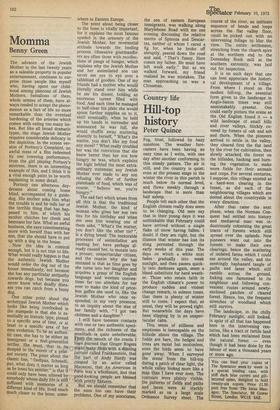Country life
Hill-top history
Peter Quince
Fog, frost, followed by hazy sunshine. The weather forecasters have been having an easy time as I write, with one day after another conforming to this steady pattern. The air is still, and the country is quiet; even at the present stage in the winter the river in this parish is much below its normal level, and flows meekly .through a landscape that is more than half asleep.
People tell each other that the English climate really does seem to be changing. Old men say that in their young days it was unthinkable that February could have arrived without a single flake of snow having fallen. I doubt if they are right, but the illusion that winter has lost its sting persisted through the early weeks of this year. The days on which a white mist fades • gradually into weak sunlight, and then passes quickly into darkness again, seem a bland substitute for hard weather. Those who retain faith in the English climate's power to produce sudden and violent change remark, in solemn tones, that there is plenty of winter still to come. I expect that, as usual, they will be proved, right.
But meanwhile the days have been slipping by in an unspectacular calm.
This sense of stillness and emptiness is inescapable on the hillside above the village. The fields are bare, the hedges and trees are moist but motionless, even the birds seem to have gone away. When I surveyed the scene from the hill-top during a patch of clear light, the whole valley looked more like a map than I have ever seen. The contours were plainly visible, the patterns of fields and paths and lanes were as starkly marked as on a large scale Ordnance Survey sheet. The course of the river, an intricate sequence of bends and loops across the flat valley floor, could be picked out with no intervening foliage to blur the view. The entire settlement, stretching from the church spire at the northern end to the Domesday Book mill at the southern extremity, was laid out for inspection.
It is on such days that one can best appreciate the historical development of a village. From where I stood on the modest hill-top, the essential form given to the landscape in Anglo-Saxon times was still unmistakably present. One could easily picture the scene as the Old English found it — a wild landscape of small hills and river valleys, thickly covered by forests of oak and ash and thorn. When the pioneers arrived to settle in the valley, they cleared first the flat land by the river for cultivation, then slowly attacked the forest on the hillsides, hacking and burning the vegetation to make more fields for their animals and crops. For several centuries, I suppose, this village existed as a hard-won clearing in the forest, as did each of the neighbouring villages which are dotted about the countryside in every direction.
After that came the next phase, when the Norman Conquest had settled into history and mediaeval man was industriously colonising the great tracts of forests which still spread over the uplands. New pioneers went out into the forests to make their own clearings; hence the scattering of isolated farms which I could see around the valley, and the seemingly haphazard tangle of paths and lanes which still ramble across, the ground, linking one farmstead to its neighbour and following convenient routes around newlyenclosed patches of cleared forest. Hence, too, the frequent stretches of woodland which still survive.
The landscape, in the chilly February sunlight, still looked, in spite of all that has happened here in the intervening centuries, like a tract of fertile land which had been reclaimed from the natural forest — even though it had been done by the labour of men a thousand years or more ago.


































 Previous page
Previous page